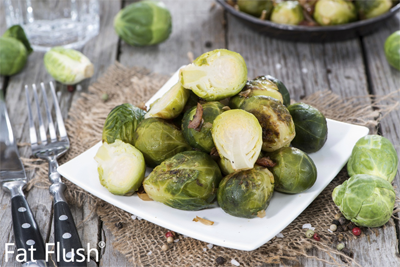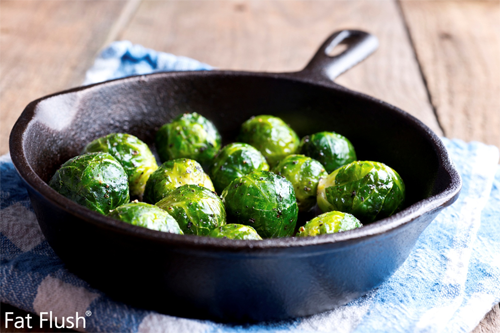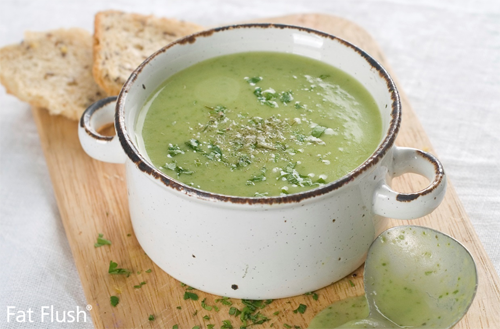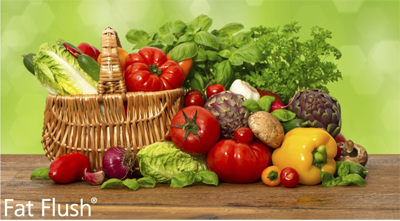
by ffadmin | Apr 8, 2014 | Tips & Tricks
Spring is in the air and now is the perfect time to start exploring the light flavors of a warmer season!
Nature is blooming with renewed energy and this is the best time of the year to turn attention to nutrient-rich produce for complete liver detoxing power. It’s time to leave behind the heavy foods of winter and start exploring the fresh, lighter flavors of Spring!
Artichokes
With powerful antioxidants and phytonutrients such as cynarin and silymarin, artichokes are a super-food for your liver. They are also high in potassium, which improves heart health, and fiber for healthy digestion.
Try it in our Baked Chicken and Artichoke Casserole.
Asparagus
These amazing stalks are high in potassium and low in sodium, helping to fight water retention by flushing out excess fluids. Asparagus also contains high amounts of inulin, a prebiotic that helps feed the good bacteria in your digestive system.
Try our easy Roasted Asparagus recipe.
Broccoli
This cruciferous vegetable offers a full bounty of iron, vitamins A and C, potassium, and fiber. The chromium in broccoli has been known to maintain stable blood sugar levels.
Try our Citrus Broccoli recipe.
lard Greens
A cousin to kale and cabbage, these greens are wonderfully nutritious. Containing both soluble and insoluble fiber, collards are ideal for keeping cholesterol in check and digestion moving smoothly. These leafy greens also contain healthy amounts of iron, calcium, and vitamins A, C, and K.
Try our recipe for Spicy African Collard Greens.
Cucumbers
Crunchy and fibrous, this veggie also offers plenty of vitamin C, potassium, and magnesium. Cucumbers also contain a healthy dose of silica which is essential to healthy connective tissue; it helps build strong bones, muscles, and tendons.
Try our recipe for Cucumber Kinda-Caprese Salad or Cucumber Mint Smoothie.
Endive
Native to the Asian region, endive is another leafy vegetable that offers lots of fiber which helps reduce cholesterol levels. It is also rich in beta-carotene and vitamin A which aids in healthy skin, good eye sight, and strong lung health.
Enjoy fresh endive leaves paired with our Homemade Salsa instead of chips.
Jicama
A powerful root, jicama is a solid source of fiber— 1 cup of jicama provides almost 6 grams of fiber. Bursting with vitamin C, it can help keep LDL (‘bad’) cholesterol from oxidizing and can also help protect against heart disease.
Try our recipe for Jicama Salad.
Kale
These leafy greens provide more nutritional value for fewer calories any other food. Kale is one of the best vegetable sources of vitamin A, plus calcium, manganese, and vitamin C.
Try our recipe for Kale Chips or this Green Apple & Kale Smoothie.
Spinach
Packed with antioxidants like vitamins C and E, beta-carotene, and zinc, spinach helps battle damaging free radicals. The high vitamin A content fortifies mucous membranes, respiratory system and is a key component for healthy white blood cells, all of which help fight infections and strengthen immunity.
Try our Lime Booster Smoothie.
Onions
Though they may bring tears, raw onions help with production of HDL (‘good’) cholesterol in the body. Onions also contain chromium which can stabilize blood sugar and quercetin, a powerful antioxidant.
Enjoy onions in our simple Shrimp Ratatouille recipe.
Watercress
A cousin of cruciferous veggies like broccoli and Brussels sprouts, watercress is known to offer over 15 essential vitamins and nutrients. Though it covers an array of nutrients, these leafy greens tout an extremely high vitamin K content which is crucial for good bone and brain health.
Try our recipe for Fat Flush-Friendly Chicken Salad.
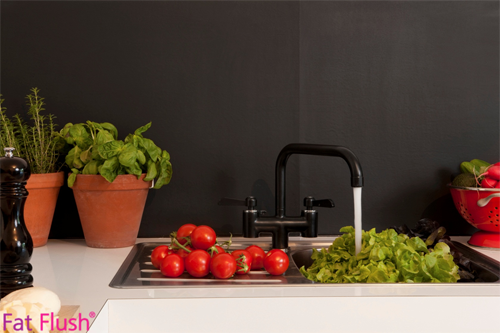
by ffadmin | Mar 14, 2014 | Tips & Tricks
Food Network Magazine released their 100 Greatest Cooking Tips (of all time!) list with tips from top chefs across the country. Here is an excerpt from that list, for Fat Flush-friendly kitchens everywhere!
1. Remember, y’all, it’s all about the prep. Take away the stress by doing the prep the night or day before. You’ll look like a star.
Paula Deen
2. Store spices in a cool, dark place, not above your stove. Humidity, light and heat will cause herbs and spices to lose their flavor.
Rick Tramonto
3. Always make stock in a large quantity and freeze it in plastic bags. That way, when you want to make a nice soup or boil veggies, you can simply pull the bag out of the freezer.
Charlie Trotter
4. After working with garlic, rub your hands vigorously on your stainless steel sink for 30 seconds before washing them. It will remove the odor.
Gerard Craft
5. For rich, creamy dressings made healthy, substitute half the mayo with Greek-style yogurt.
Ellie Krieger
6. When chopping herbs, toss a little salt onto the cutting board; it will keep the herbs from flying around.
Joanne Chang
7. If you keep it simple and buy ingredients at farmers’ markets, the food can pretty much take care of itself. Do as little as possible to the food; consider leaving out an ingredient and relying on instinct.
Tony Mantuano
8. Homemade vinaigrettes have fewer ingredients and taste better than bottled ones. No need to whisk them: Just put all the ingredients in a sealed container and shake.
Bill Telepan
9. When making meatballs or meatloaf, you need to know how the mixture tastes before you cook it. Make a little patty and fry it in a pan like a mini hamburger. Then you can taste it and adjust the seasoning.
Isaac Becker
10. Instead of placing a chicken on a roasting rack, cut thick slices of onion, put them in an oiled pan, then place the chicken on top. The onion will absorb the chicken juices. After roasting, let the chicken rest while you make a sauce with the onions by adding a little stock or water to the pan and cooking it for about 3 minutes on high heat.
Donald Link
11. Take the time to actually read recipes through before you begin.
John Besh
12. Recipes are only a guideline, not the Bible. Feel comfortable replacing ingredients with similar ingredients that you like. If you like oregano but not thyme, use oregano.
Alex Seidel
13. Taste as you go!
Anne Burrell
14. For safety, put a wine cork on the tip of a knife before putting the knife in a drawer.
Giuseppe Tentori
15. When you’re going to sauté garlic, slice it rather than mincing it — it’s less likely to burn that way.
Aarti Sequeira
16. Smash garlic cloves inside a resealable plastic bag with the back of a knife. That way, your cutting board and knife won’t smell.
Laurent Tourondel
17. To get nice, crispy caramelization on roasted vegetables, simulate the intense heat of an industrial oven: Bring your oven up as hot as it goes, then put an empty roasting or sheet pan inside for 10 to 15 minutes. Toss the vegetables — try carrots or Brussels sprouts — with olive oil, salt and pepper, and put them on the hot pan. This method will give you the high heat you need to caramelize the sugars in the vegetables quickly.
Naomi Pomeroy
18. Marinating meat with citrus can give it a mealy texture. If you like citrus, a little squeeze of lemon or lime is always a good way to finish the dish instead.
Tim Love
19. Always use sharp knives. Not only is it safer but it will make your work much more efficient.
April Bloomfield
20. Rest, rest, rest! Always let your meat rest — especially off a hot grill!
Melissa d’Arabian
21. Plunge vegetables in ice water after blanching (boiling) them so they maintain a bright color.
Maria Hines
22. Don’t overcrowd the pan when you’re sautéing — it’ll make your food steam instead.
Ryan Poli
23. Buy fruit at its peak at a farmers’ market and freeze it in an airtight container so you can enjoy it year round.
Mindy Segal
24. Fresh basil keeps much better and longer at room temperature with the stems in water.
Elisabeth Prueitt
25. Season all of your food from start to finish. Seasoning in stages brings the most out of your ingredients and gives you the most flavor.
Jose Garces
26. Taste what you make before you serve it. I’m amazed that people will follow a recipe but not taste the dish to see if it needs more salt, pepper or spices.
Brad Farmerie
27. Season fish simply and cook it with respect. The flavor of the fish is what you want. When it comes off the grill or out of the oven or pan, finish it with a little squeeze of fresh lemon juice. Always. There is just something about lemon and fish that is heavenly.
Rick Moonen
28. If you’re cooking cauliflower, add a bit of milk to the water with salt to keep the cauliflower bright white. Shock it in cold water to stop the cooking and then serve.
Michael White
29. When you grill, pull your steaks out of the refrigerator one hour ahead of time so they can come to room temperature.
Geoffrey Zakarian
30. When using fresh herbs such as cilantro or parsley, add whole stems to salads and sandwiches, and chop and stir leaves into salsas and guacamole.
Aarón Sánchez
31. To optimize the juice you get from a lemon or lime, roll it hard under your palm for a minute before juicing. (Or — never say I told you this — microwave it for 10 to 15 seconds.)
Patricia Yeo
73. Have your mise en place ready: Do all of your cutting of vegetables and meat and make your sauces before you start cooking.
Richard Sandoval
32. Shoes off, music on, favorite beverage in hand — enjoy your time in the kitchen.
Claire Robinson
33. Always buy the freshest garlic you can find; the fresher it is, the sweeter it will be. The best garlic has firm tissue-like skin and should not be bruised, sprouted, soft or shriveled. If you find cloves that have green shoots, discard the shoots — they will only add bitterness.
Todd English
34. Keep flavored vinegars near the stove so you won’t always reach for the salt. Acid enhances flavor.
Art Smith
35. Don’t be too hard on yourself — mistakes make some of the best recipes! Keep it simple.
Sunny Anderson
36. Prolong the lifespan of greens by wrapping them loosely in a damp paper towel and placing in a resealable plastic bag. That local arugula will last about four days longer.
Hugh Acheson
37. Cook more often. Don’t study; just cook.
Masaharu Morimoto
38. Make sure the handle of your sauté pan is turned away from you so you don’t hit it and knock it off the stove. It happens all the time.
Jonathan Waxman
39. Don’t dress the salad when having a big party. Leave it on the side and let the people do it themselves. I’ve had too many soggy salads because of this.
Marc Forgione
40. When cooking eggplant, I like to use the long, skinny, purple Japanese kind because you don’t have to salt it to pull out the bitter liquid like you do with the larger Italian variety.
Andrew Carmellini
41. Don’t be afraid to ask the butcher or fishmonger to see the products up close and to smell for freshness. Fish should never smell fishy.
Eric Ripert
See the full list of Food Network Magazine’s 100 Greatest Cooking Tips (of all time!).

